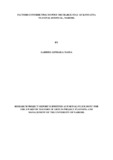| dc.description.abstract | Discharge planning is embedded in the clinical pathway of patient’s treatment in hospitals
during overnight admissions. Actual discharge from a hospital allows patients to leave the
facility and convalescence at their homes while preparing to resume normal lives. This also
creates space for other overnight admissions and eases stress within the referral system.
However, a number of patients are unable to leave health facilities after clinical discharge
where co-payments and user fees are required to facilitate clearance. This study was based at
Kenyatta National Hospital (KNH), the apex of the referral health care system in Kenya and
sought to understand factors that contribute to post discharge stay (PDS) in KNH. This study
evaluated the effects of socio-demographic, health insurance status, social support and nature
of illness as components of post discharge stay in KNH. Moreover, factors contributing to
post discharge stay as a barrier of exit from a health facility has not been systematically
explored by previous research as most studies have dwelt on access and equity of healthcare.
This descriptive survey targeted discharged patients in KNH who were unable to clear their
hospital bills and health workers involved in the administration of systems which assist
discharged patients leave the hospital. Patients (n=186) had an average post discharge stay of
33.3 (SD 12.6) days, and 78% came from Nairobi and its metropolis. Further, 52% of the
patients were not referred to the facility while only 17.2% reported to have no occupation. Of
the patients with No NHIF (95.5%), 78.6% cited lack of knowledge on NHIF benefits as nonenrolment
reason. Patients with higher level of social support were able to obtain instrumental
aid (p=0.000) than those with low levels of social support, although the support was not
substantial enough to wholly influence post discharge stay. Although social-demographic and
clinical characteristics were not statistically significant with post discharge stay, a positive
trend was observed as both influenced ability to pay and size of hospital bills respectively.
Importantly, the ability to leave the facility was at the discretion of the hospital administration
and the absence of a viable coping mechanism within households influenced post discharge
stay. The results revealed two post discharge groups with distinctive characteristics. The low
income group with low risk aversion and were willing to pay an agreed pre-payment premium
and the impoverished poor. From a NHIF hypothetical model, 90.3% of outstanding bills
would be covered in full while 9.7% would be co-shared and this showed health insurance
status would influence post discharge stay. Therefore, NHIF and other forms of pre-payment
should be considered as an integral part in public health care financing. Projects to enhance
the low penetration of health insurance for unregistered eligible members of the population
should be adopted. Medical programmes should seek convergence with economic
programmes such as social protection initiatives for vulnerable groups involving clear
eligibility criteria and matching funds provided to sustain health facilities. | en_US |

